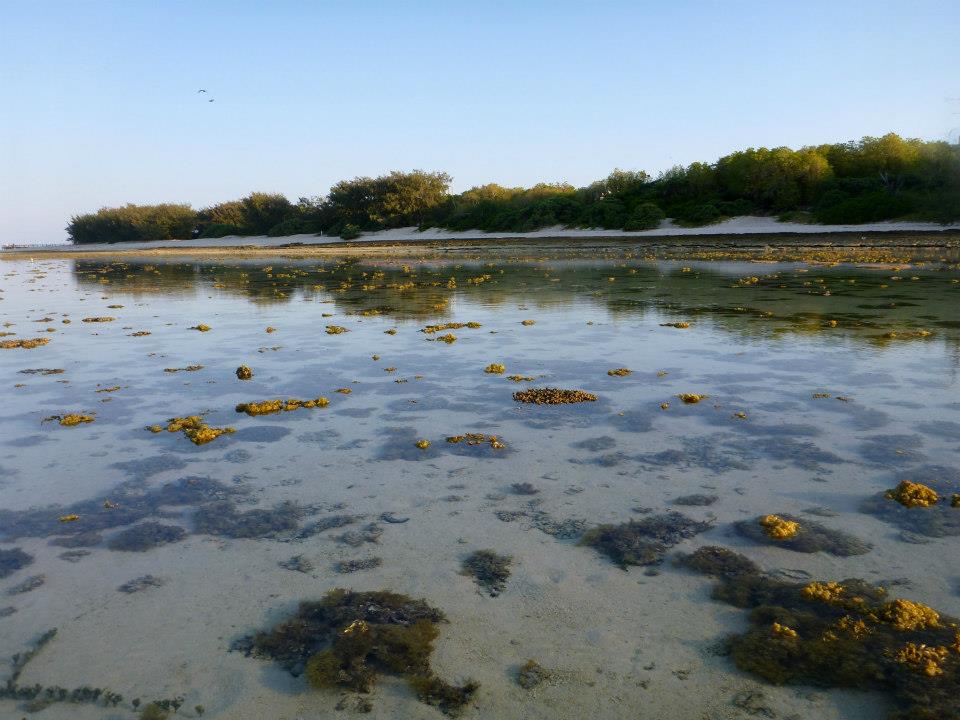Ecology
 
Caphyra rotundifrons is found in filamentous green algae Chlorodesmis fastigiata (pictured on left). This algae is found growing in rocky pools or on reef flats, such as Heron Island (pictured on right). Photos by Philippa Jenkins.
Summary
Two experiments were performed to determine habitat preference of C. rotundifrons. Algal patches with and without Caphyra rotundifrons were collected to see if the volume and animal communities of Chlorodesmis fastigiata patches differed between patches with crabs present and without crabs present. There was no significant different between algal volume and crab presence, but there was a relationship between the crab size (measured as carapace width) and algal patch volume in algal patches with crabs present. There was no significant difference in algal communities except for copepods, which were found in higher numbers in algal patches with crabs. As copepods provide no food for C. rotundifrons, it is more likely that the copepods choose the algal patches based on crab presence than vice versa.
Introduction
Unlinke most of the Caphya genus, which live on soft corals, Caphyra rotundifrons lives solely amongest the green filamentous algae Chlorodesmis fastigiata (Apel & Steudel, 2001).Hay et al. (1989) tested the preference of the crab for different algae, and found that it chose Chlorodesmis fastigiata almost every time. The same study also found that living in the C. fastigiata significantly reduced predation on the crab than when it was living in other species.
I aim to determine how C. rotundifrons might choose between different patches of C. fastigiata. In particular, I aim to determine whether the size of the clump has an effect on the presence and absence of a crab, and whether the communities living in the C. fastigiata are altered by the presence of a crab.
Methods
C. fastigiata clumps were collected from a study site at Heron Island, on the Southern Great Barrier Reef, Ten patched were collected with crabs, and ten without crabs. Due to the cryptic nature of this species, algae patched were felt by hand to find if a crab was present, as in Hay et al. (1989). C. fastigiata patches were removed from the substrate using a knife to cut the holdfast of the algae.
C. fastigiata patches were placed in freshwater to shock any animals living in them out of them, and then filtered using a 250µm sieve. This was done multiple times until no more animals emerged. The animals were kept for analysis later, and preserved in a 70% ethanol solution. Any C. rotundifrons present had carapace width measured, and the average carapace width was determined for each algal patch. The volume of each algae patch was then measured using a measurinig cylinder filed with water and the change in water level recorded.
One the communities of the algae were identified, Student's t-tests were run to determine signficance.
Results
Algal patches with crabs had either 1 or 2 crabs. There was no significant relationship between the size of the algae patch and presence of a crab (p= 0.92, 2-tails). However, there was a significant relationship between the average carapace width and the size of the algal patch (p=0.021, 2-tail, paired). Carapase width ranged from 0.3cm - 1.3cm.
The main phylum found in Chlorodesmis fastigiata was arthropoda, specifically crustacea. Of this phylum four orders of malacostraca were found: copepoda, amphipoda, decapoda and isopoda. Below is a list of all phyla found:
- Arthropoda
- Annelida
- Nematoda
- Mollusca
In addition, foraminifera and diatoms were quite common, but not present in all algal patches.Two spider crabs were also found in an algal patch with 2 C. rotundifrons individuals - these are currently being identified by the Queensland Museum.
There was no significant relationship between the number of phyla found in patched with crabs and without. See figure 1 for average number of phyla found. There was no significant difference between the number of crustacean ordes, or the numbers found of the different phyla except for copepods, which were found in significantly higher numbers in the algal patches with crabs (p=0.040, 1-tail, unpaired).

Figure 1: Average number of phyla found in Chlorodesmis fastigiata patches with C. rotundifrons present, and C. fastigiata patches without C. rotundifrons.. Error bars denote standard error
Discussion
The results suggest that other factors than size determine what algal patches a crab selects. They do indicate that larger crabs will select larger habitats over small. This is probably due to predator avoidance, as larger crabs would get more protection from predators in larger patches than they would in smaller patches, so once they grow large enough, they would relocate. Predation of C. rotundifrons does still occur in C. fastigiata (Hay et al., 1989).
Any diffence in algal communities would be attributed to one of two factors: either the crab prefers a certain type of algal community, or once the crab enters a patch, the communities change. The results suggest that neither of these is true, although the community of copepods did differ. As crabs do not feed on anything except for C. fastigiata (Hay et al., 1989), it suggests that the copepods select for algal patches with C. rotundifrons, rather than C. rotundifrons selects for patches with copepods. Therefore, it is probable that C. rotundifrons does not select algal patches based on algal communities.
|